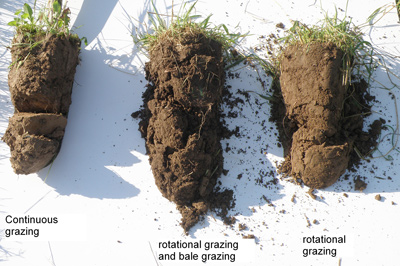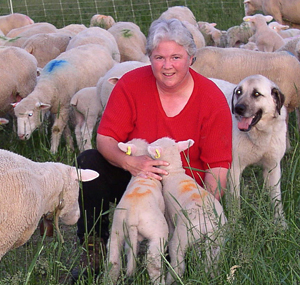By Janet McNally
Hinckley, Minnesota—In past articles I’ve described how much more productive my managed pastures have been compared to the continuously grazed pasture right across the fence line.
I’ve also told how much more productive and drought-tolerant my pastures have become since I moved toward a mob-grazing system with more frequent moves and longer (six- to eight-week) rest periods. I always attributed the improvement to deeper roots and better plant vigor, both of which tend to be true when plants have longer rest periods.
But just this year I’ve learned that something else is going on in my soils that is playing a major role in that improvement. It looks like my winter hay-feeding system is doing even more than the summer grazing to improve soil health and plant growth.

These soil samples show that bale grazing offers some serious soil health benefits.
Bale grazing explained
My winter system is what some people call “bale grazing.” Each fall, round bales are set out on pasture, and they are not moved during the winter. I developed this system after some old-fashioned winters with heavy snow. With the hay already out in the pasture, I no longer need to start a tractor at 30-below or worry about how to get feed to sheep after getting two feet of snow. Sheep have access to the entire paddock full of bales, and graze two or three at a time.
When they’re done, a four-inch thick layer of heavily manured residue remains. I’ve estimated about 150 lbs. of hay are left behind per 1,000-pound bale. This gives the ewes a warmer place to settle down on during cold winter weather, and also insulates newborn lambs in the spring. (See accompanying article for some bale grazing tips.)
It is also a very efficient way to capture nutrients. In 2008, Paul Jungnitsch, a graduate student at the University of Saskatchewan in Canada, found nutrient retention with bale grazing to be superior to that of other traditional manure handling systems that involve handling and spreading, even if the manure being handled is composted.
Measuring the nutrients in the forages that subsequently grew where the bale once sat, Jungnitsch found that 34% of the nitrogen from the hay and 38% of the nitrogen excreted by the animals was retained. For phosphorus, 22% was retained from the hay and 26% was retained from the urine and manure.
In comparison, only 1% of the nitrogen and 3% of the phosphorus were retained from either raw or composted manure that was scraped in the yard and spread on the pasture. When manure is spread, nutrients volatilize and are lost to the atmosphere. But they stay put in a pile of undisturbed hay residue.
Here in Minnesota, that hay residue remains frozen longer due to the insulating qualities of the hay. Urine and manure do not run off with the spring snowmelt, instead staying tied up in the frozen hay until the surrounding earth has begun to thaw.
I have measured 3.5 times more forage growing on this hay residue, both later in the season and in subsequent years, compared to ground that never had a hay bale upon it. So I make sure the bales are delivered to the areas showing the poorest fertility. I always attributed the extra plant growth solely to the added nutrients supplied by the hay residue, manure and urine.
Digging for answers
But after seeing the results of what mob grazing can do for soil structure at the 2013 Grassfed Exchange Conference, I began to wonder what more might be going on below the surface.
I decided to dig up and compare some soil samples (see photo on the previous page). As expected, there were more roots and deeper roots in the sample that was rotationally grazed compared to the sample from the continuously grazed side. But there were more differences. The continuously grazed side had a hardpan of saturated clay about a foot down and there were no roots below this pan. The rotationally grazed side had a more porous soil structure and, although the hardpan is visible, it was clearly penetrated and obscured by the roots. The hardpan was damp but not saturated, suggesting that the recent rains had percolated through it.
The really surprising sample came from an area where a bale once sat. I have no idea how long ago it was there, but a twine in the sample and what I found in the soil made it obvious that a bale indeed had been there.
While I was not too surprised to find three inches of rich, black soil above the twine, I wasn’t expecting what was below. The entire, 18-inch spade full of soil had a nice porous soil structure rich with roots, organic matter and earthworms. The hardpan was not even present, even though one was visible in the sample taken from just 30 feet away where a bale had never sat.
The rich organic matter above the twine was not a surprise given the residue of hay, manure and urine that would have jumpstarted some biological activity. But I just never expected such a dramatic difference well below the hay layer.
Measuring infiltration
I decided to test the water infiltration rate. This is done with a pipe six inches in both diameter and length, pounded about four inches into the soil. I used a three-pound coffee can with the bottom removed. I poured 440 ml of water into the pipe to create one inch of water above the soil, and then recorded the time required for that water to soak in.
A huge difference
On the site where a bale had sat, all of the water infiltrated within five seconds. On the rotationally grazed area where a bale had not sat, three-eighths of inch of water remained in the can after 15 minutes, but it was percolating into the soil very slowly.
On the neighbor’s pasture where the cows had been set-stocked for 25 years, there was still three-quarters of an inch of water in the can after 15 minutes, and the level had not changed in the previous five minutes. The water remaining on the surface roughly reflects the amount of water that will run off with a heavy downpour.
No doubts about it
There is no question that mob stocking and rotational grazing are changing our soils by increasing biological activity and improving soil structure. It is also clear that bale grazing can be used to jumpstart biological activity and change soil structure much more quickly and dramatically. Winter feeding is a given in the northern states, and for the benefit of our soils, as much of that hay as possible should be fed out in pastures while the ground is frozen.
Some bale-grazing tips for sheep
Here are a few bale-grazing tips for sheep:
- Long-stemmed, grassy hay works better than hay with high legume content. Sheep waste legume hay, and alfalfa leaves contaminate fleeces.
- The bales need to be round, not square. Bales under 1000 lbs. are safer than bigger bales. Sheep tend to eat the lower portions of larger bales, creating a mushroom shape that will topple and possibly crush animals. Smaller bales are less likely to tip.
- Place bales in the pasture at a minimum spacing of 30 feet (the farther apart, the better), taking care to place them where soil fertility is lacking. All bales can be set at the beginning of the winter season, or a few can be placed daily. Compared to cattle and horses, sheep are much less inclined to make a bed out of each bale, instead working on only a few bales at a time — especially in deep snow.
- Bale grazing requires sufficient numbers to create a bit of a competitive atmosphere that will help assure the least amount of waste. Sixty or more ewes have worked well for me. Higher-precipitation areas with abundant wet snow may see more waste than drier areas.
- Bale grazing may not be suitable in the South where soils do not freeze, as the pugging damage and inevitable grazing of semi-dormant forages may offset the benefits.
Janet McNally grazes sheep near Hinckley, Minnesota.

